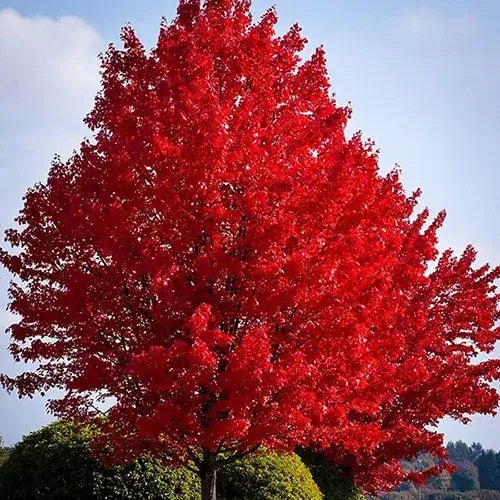There are over one hundred varieties of maple trees, and they grow over a wide range of territory, including Norway. Many are native varieties that can be planted in your yard for shade.
They make excellent shade trees and can grow anywhere from ten feet to over one hundred feet tall. The canopy can also be extensive, probably one of the reasons they are such famous shade trees.
They have what are called 'keys' that spin and fall during the autumn to seed or be eaten the following year. Many animals like seeds and can use them as a resource during the winter.
They all turn color in the fall, and the color of the leaves can range from light yellow to a deep and beautiful red. Some even have a red tint on the stems beginning in fall and lasting through the spring. These are usually the new branches beginning to sprout. Some also have red flowers and berries.
This maple will be red during the spring when sprouting leaves and turn a deep red as the 'sugar' in them is affected by frost in the fall. The red maple can be found along the eastern seaboard and the south as far as Texas, but not much further. They can exist in various soils, from swamp conditions to slightly dry ones.
The silver maple has a reasonably large leaf spread and has a frosty or silver under-leaf that is beautiful and quite striking in the breeze or wind. It has sugar like the other varieties and 'bleeds' but is not well known for being used as a product for maple syrup.
The sugar maple is most commonly found in the Northwestern United States and is the source of the familiar maple syrup that farmers harvest in early spring. This is still cooked by hand in some areas of the Northwest, and you can often smell it when traveling in Vermont and Main and other parts of the 'original colonies.'
The October glory maple has red flowers in spring and red berries that the animals love. It is generally about thirty feet tall and is a rapidly growing maple.
This maple grows all over the northern/southern region of the country, mainly in the northern half of the U.S. from east to west. It, like other maples, tends to have knots that woodworkers make into furniture.
All maples are popular for wood-making; some have harder woods than others. The red sunset maple has red flowers in spring and berries as well. Birds and animals love them.
They are often planted along highways because they are relatively hardy trees. The benefit of this maple is that it will grow from the Northern border of the U.S. to the Southern border.
Any gardener or homeowner loves it because it takes little care once it is established. One negative thing about maples is that they may invade underground pipes and plumbing, but some varieties have shallow roots and are not a problem.
However, if you live along the coast, you might prefer one of the deep-rooted species. Whichever maple you choose, you will enjoy the many advantages of maples for a lifetime.











































































































